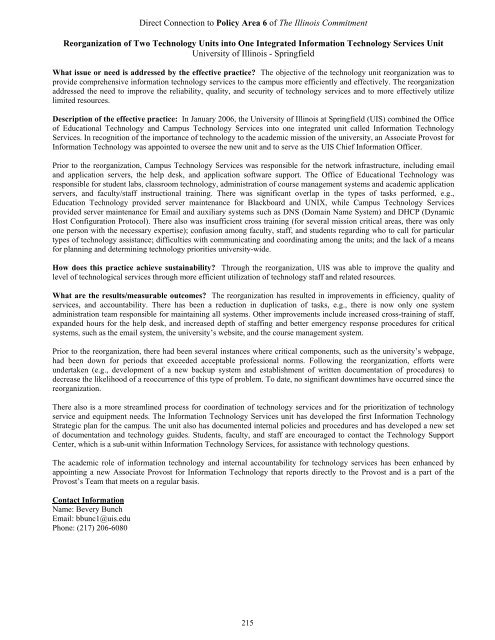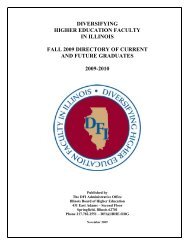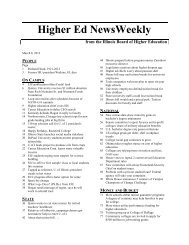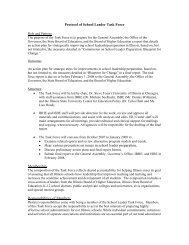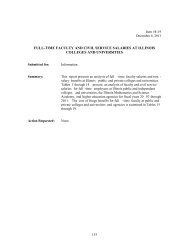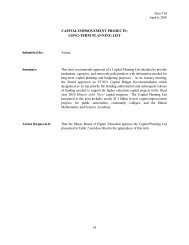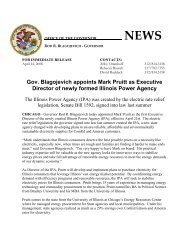Title of Effective Practice: - California Postsecondary Education ...
Title of Effective Practice: - California Postsecondary Education ...
Title of Effective Practice: - California Postsecondary Education ...
Create successful ePaper yourself
Turn your PDF publications into a flip-book with our unique Google optimized e-Paper software.
Direct Connection to Policy Area 6 <strong>of</strong> The Illinois Commitment<br />
Reorganization <strong>of</strong> Two Technology Units into One Integrated Information Technology Services Unit<br />
University <strong>of</strong> Illinois - Springfield<br />
What issue or need is addressed by the effective practice? The objective <strong>of</strong> the technology unit reorganization was to<br />
provide comprehensive information technology services to the campus more efficiently and effectively. The reorganization<br />
addressed the need to improve the reliability, quality, and security <strong>of</strong> technology services and to more effectively utilize<br />
limited resources.<br />
Description <strong>of</strong> the effective practice: In January 2006, the University <strong>of</strong> Illinois at Springfield (UIS) combined the Office<br />
<strong>of</strong> <strong>Education</strong>al Technology and Campus Technology Services into one integrated unit called Information Technology<br />
Services. In recognition <strong>of</strong> the importance <strong>of</strong> technology to the academic mission <strong>of</strong> the university, an Associate Provost for<br />
Information Technology was appointed to oversee the new unit and to serve as the UIS Chief Information Officer.<br />
Prior to the reorganization, Campus Technology Services was responsible for the network infrastructure, including email<br />
and application servers, the help desk, and application s<strong>of</strong>tware support. The Office <strong>of</strong> <strong>Education</strong>al Technology was<br />
responsible for student labs, classroom technology, administration <strong>of</strong> course management systems and academic application<br />
servers, and faculty/staff instructional training. There was significant overlap in the types <strong>of</strong> tasks performed, e.g.,<br />
<strong>Education</strong> Technology provided server maintenance for Blackboard and UNIX, while Campus Technology Services<br />
provided server maintenance for Email and auxiliary systems such as DNS (Domain Name System) and DHCP (Dynamic<br />
Host Configuration Protocol). There also was insufficient cross training (for several mission critical areas, there was only<br />
one person with the necessary expertise); confusion among faculty, staff, and students regarding who to call for particular<br />
types <strong>of</strong> technology assistance; difficulties with communicating and coordinating among the units; and the lack <strong>of</strong> a means<br />
for planning and determining technology priorities university-wide.<br />
How does this practice achieve sustainability? Through the reorganization, UIS was able to improve the quality and<br />
level <strong>of</strong> technological services through more efficient utilization <strong>of</strong> technology staff and related resources.<br />
What are the results/measurable outcomes? The reorganization has resulted in improvements in efficiency, quality <strong>of</strong><br />
services, and accountability. There has been a reduction in duplication <strong>of</strong> tasks, e.g., there is now only one system<br />
administration team responsible for maintaining all systems. Other improvements include increased cross-training <strong>of</strong> staff,<br />
expanded hours for the help desk, and increased depth <strong>of</strong> staffing and better emergency response procedures for critical<br />
systems, such as the email system, the university’s website, and the course management system.<br />
Prior to the reorganization, there had been several instances where critical components, such as the university’s webpage,<br />
had been down for periods that exceeded acceptable pr<strong>of</strong>essional norms. Following the reorganization, efforts were<br />
undertaken (e.g., development <strong>of</strong> a new backup system and establishment <strong>of</strong> written documentation <strong>of</strong> procedures) to<br />
decrease the likelihood <strong>of</strong> a reoccurrence <strong>of</strong> this type <strong>of</strong> problem. To date, no significant downtimes have occurred since the<br />
reorganization.<br />
There also is a more streamlined process for coordination <strong>of</strong> technology services and for the prioritization <strong>of</strong> technology<br />
service and equipment needs. The Information Technology Services unit has developed the first Information Technology<br />
Strategic plan for the campus. The unit also has documented internal policies and procedures and has developed a new set<br />
<strong>of</strong> documentation and technology guides. Students, faculty, and staff are encouraged to contact the Technology Support<br />
Center, which is a sub-unit within Information Technology Services, for assistance with technology questions.<br />
The academic role <strong>of</strong> information technology and internal accountability for technology services has been enhanced by<br />
appointing a new Associate Provost for Information Technology that reports directly to the Provost and is a part <strong>of</strong> the<br />
Provost’s Team that meets on a regular basis.<br />
Contact Information<br />
Name: Bevery Bunch<br />
Email: bbunc1@uis.edu<br />
Phone: (217) 206-6080<br />
215


